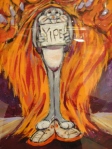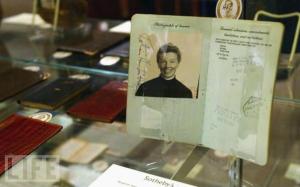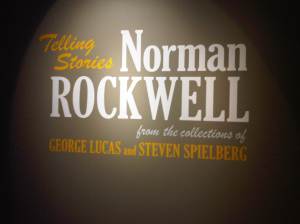 Washington, DC is a place of monuments and spectacle. Theatre in politics and theatre on performing stages. Washington also is a city I called home for eight years and a part of me will always be a bit in love with it — as an American city, as an assemblage of awe-inspiring architecture, as a city chock-full of world-class museums and surprise exhibits.
Washington, DC is a place of monuments and spectacle. Theatre in politics and theatre on performing stages. Washington also is a city I called home for eight years and a part of me will always be a bit in love with it — as an American city, as an assemblage of awe-inspiring architecture, as a city chock-full of world-class museums and surprise exhibits.
On a visit earlier this week, I stayed on 7th Street near theatres (including Shakespeare and Woolly Mammoth) and museums (including National Gallery of Art, the Building Museum, and two Smithsonian venues — the National Portrait Gallery, and the American Art Museum) and views of the Capital and the Washington Monument. At the Building Museum I chanced upon an exhibit about America’s SIX world fairs during the Depression 1930s (from Chicago to New York and four other locations in between). Another surprise was suggested to me by a new pal by email during my visit. Be sure to visit the Rockwell show while you’re there, he said. He had traveled to DC from New York City a few months ago especially for this exhibit. I was in the midst of moving from Philadelphia to New York City during the middle part of this calendar year when this exhibit opened and hadn’t heard about it, but during that time period I was at the time lucky if I could attend to what was directly in front of my face. Now that I was alerted to it’s existence, his exhibit by subject matter was one crafted for me, I thought. And boy oh boy, did I have that right.
“Telling Stories: Norman Rockwell from the Collections of George Lucas and Steven Spielberg”
1st floor West, American Art Museum, Washington DC
July 2, 2010 — January 2, 2011
http://americanart.si.edu/exhibitions/archive/2010/rockwell/
Steven Spielberg and George Lucas have donated extensive portions of their private collections for a unique exhibit honoring perhaps the most iconic presentational American artists of the early and middle 20th century: Norman Rockwell. Many millions know Rockwell’s work from decades of crafting magazine cover images for The Saturday Evening Post and other publications. What Spielberg and Lucas as young men resonated to in the work of this older man is outlined in a short film created for the exhibition called “George Lucas and Steven Spielberg: Reflections on Rockwell.” The film runs in a loop in the corner of the display and features the two filmmakers discussing Rockwell and their drive to collect his prints, drawings, and paintings. To these two collectors, Rockwell’s pieces were cast, scripted, staged to move us through the stories they tell or simply suggest. The artist’s works are intensely cinematic, they tell us. We don’t always know for sure what has happened in each scenario portrayed in Rockwell’s still pictures, but we can impose a story, just as we always do when we view human tableaux in train stations or in parks or at neighboring tables in restaurants. These are human stories in snapshots.
- Rockwell: “A cover should be more than a one-line joke.”
- Rockwell: “I tell the story through characters.”
- Rockwell: “Story illustrations shouldn’t give away the plot.”
- Lucas: Rockwell gives us “little bits of culture, captured like snapshots.”
- Lucas: “A picture just has to touch the emotional side of a human being.”
- Lucas on Rockwell constellations: “He cast the painting.”
- Spielberg on the world Rockwell envisioned: “probably the way we hoped it had been.”
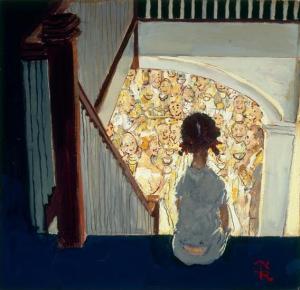
"Little Girl Looking Downstairs at Christmas Party", McCall's December 1964, oil on board, 10 x 101/2 inches, collection of George Lucas
It’s a stunning assemblage. To remember a childhood, to remember a time that was or a time that never was, to enjoy an exhibit with seniors in their 70s and 80s and kids under 10 who all enjoy the imagery and understand the stories in the paintings — this is one for your short list. My favorite image is a color oil sketch loaned by George Lucas entitled “Little Girl Looking Downstairs at Christmas Party” (for McCall’s December 1964). This image evokes my own suburban upbringing, hearing the adults downstairs, wanting to be grown up so I could be part of the laughter and story telling and know what they were talking about, yet happy enough lurking upstairs in my pajamas, observing. The budding brain of a dramaturg and observer. For some, it speaks to their inner filmmaker. Explore what the image and sister images in the gallery rooms evoke for you.
For more information on locations mentioned in this post:
- Shakespeare Theatre Company: http://www.shakespearetheatre.org/index2.aspx
- Woolly Mammoth Theatre Company: http://www.woollymammoth.net/
- National Gallery of Art: http://www.nga.gov/
- National Building Museum: http://www.nbm.org/index.html
- National Portrait Gallery: http://www.npg.si.edu/
- American Art Museum: http://americanart.si.edu/
© Martha Wade Steketee (October 13, 2010)

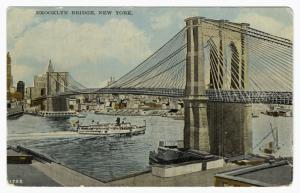
 I tend to list positives and negatives at these moments of decision (and drive my husband crazy in the process). I hope the exercise helps me to find calm in the new apartment. Naming the worst case scenario assists me in finding peace with whatever events could possibly unfold. This apartment is beautiful and gorgeously appointed in a development in which it is among the more modest layouts and price points (the old “don’t buy the best house on the block” idea). A massively cool exercise facility and pool on the premises, along with other amenities. And walking distance for hubby to work in west 50s, as well as walking distance for me to Broadway theatres and major museums. And then there are the things we don’t know — potential for construction nearby, and dwelling on one of the lower floors of this midrise building. Will I feel like a “bottom dweller”?
I tend to list positives and negatives at these moments of decision (and drive my husband crazy in the process). I hope the exercise helps me to find calm in the new apartment. Naming the worst case scenario assists me in finding peace with whatever events could possibly unfold. This apartment is beautiful and gorgeously appointed in a development in which it is among the more modest layouts and price points (the old “don’t buy the best house on the block” idea). A massively cool exercise facility and pool on the premises, along with other amenities. And walking distance for hubby to work in west 50s, as well as walking distance for me to Broadway theatres and major museums. And then there are the things we don’t know — potential for construction nearby, and dwelling on one of the lower floors of this midrise building. Will I feel like a “bottom dweller”?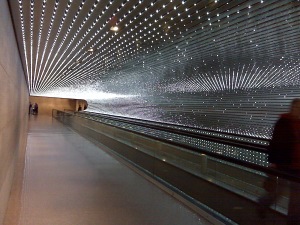
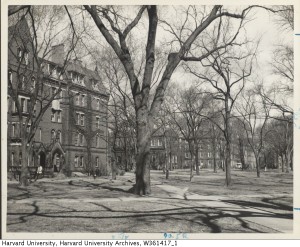

 At the cross roads of two traditions, two institutions, one an offshoot of the other, twins birthed in separate centuries (Harvard founded in 1642, Radcliffe founded as the “Harvard Annex” in 1879 with instruction of women by Harvard faculty and chartered as Radcliffe in 1894) I attended Harvard-Radcliffe during the years of a merged admissions office and a certain confusion over which school controlled the men and women scholars in attendance. In the late 1970s-early 1980s there remained a President of Harvard (male) and a President of Radcliffe (female) and both signed the diplomas of the women graduates, who were in the end graduates after 1977 of Harvard College. It took some 20 plus years more for the corporate and alumni groups to establish a Radcliffe Institute of Advanced Study (so the name still lives) and clarify that women and men were now attending one college and graduating from that one college, holding the same diploma. And within the past two years for the first time the President of Harvard University is a woman. Ah, what we’ve witnessed.
At the cross roads of two traditions, two institutions, one an offshoot of the other, twins birthed in separate centuries (Harvard founded in 1642, Radcliffe founded as the “Harvard Annex” in 1879 with instruction of women by Harvard faculty and chartered as Radcliffe in 1894) I attended Harvard-Radcliffe during the years of a merged admissions office and a certain confusion over which school controlled the men and women scholars in attendance. In the late 1970s-early 1980s there remained a President of Harvard (male) and a President of Radcliffe (female) and both signed the diplomas of the women graduates, who were in the end graduates after 1977 of Harvard College. It took some 20 plus years more for the corporate and alumni groups to establish a Radcliffe Institute of Advanced Study (so the name still lives) and clarify that women and men were now attending one college and graduating from that one college, holding the same diploma. And within the past two years for the first time the President of Harvard University is a woman. Ah, what we’ve witnessed.






